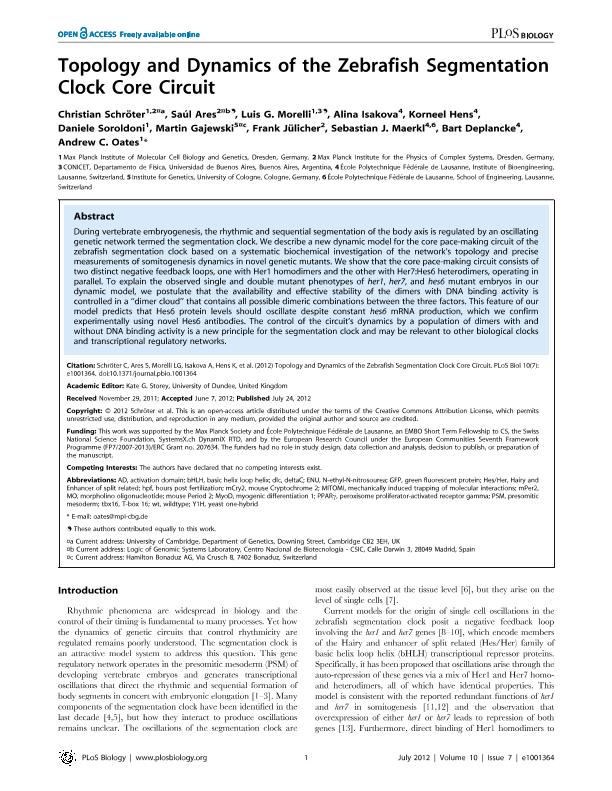Mostrar el registro sencillo del ítem
dc.contributor.author
Schroter, Christian

dc.contributor.author
Ares, Saúl
dc.contributor.author
Morelli, Luis Guillermo

dc.contributor.author
Isakova, Alina
dc.contributor.author
Hens, Korneel
dc.contributor.author
Soroldoni, Daniele

dc.contributor.author
Gajewski, Martin
dc.contributor.author
Jülicher, Frank
dc.contributor.author
Maerkl, Sebastian J.
dc.contributor.author
Deplancke, Bart
dc.contributor.author
Oates, Andrew C.

dc.date.available
2018-08-23T13:18:17Z
dc.date.issued
2012-07
dc.identifier.citation
Schroter, Christian; Ares, Saúl; Morelli, Luis Guillermo; Isakova, Alina; Hens, Korneel; et al.; Topology and dynamics of the zebrafish segmentation clock core circuit; Public Library of Science; PLoS Biology; 10; 7; 7-2012; 1001364-1001364
dc.identifier.issn
1544-9173
dc.identifier.uri
http://hdl.handle.net/11336/56741
dc.description.abstract
During vertebrate embryogenesis, the rhythmic and sequential segmentation of the body axis is regulated by an oscillating genetic network termed the segmentation clock. We describe a new dynamic model for the core pace-making circuit of the zebrafish segmentation clock based on a systematic biochemical investigation of the network's topology and precise measurements of somitogenesis dynamics in novel genetic mutants. We show that the core pace-making circuit consists of two distinct negative feedback loops, one with Her1 homodimers and the other with Her7:Hes6 heterodimers, operating in parallel. To explain the observed single and double mutant phenotypes of her1, her7, and hes6 mutant embryos in our dynamic model, we postulate that the availability and effective stability of the dimers with DNA binding activity is controlled in a "dimer cloud" that contains all possible dimeric combinations between the three factors. This feature of our model predicts that Hes6 protein levels should oscillate despite constant hes6 mRNA production, which we confirm experimentally using novel Hes6 antibodies. The control of the circuit's dynamics by a population of dimers with and without DNA binding activity is a new principle for the segmentation clock and may be relevant to other biological clocks and transcriptional regulatory networks. © 2012 Schröter et al.
dc.format
application/pdf
dc.language.iso
eng
dc.publisher
Public Library of Science

dc.rights
info:eu-repo/semantics/openAccess
dc.rights.uri
https://creativecommons.org/licenses/by-nc-sa/2.5/ar/
dc.subject
Segmentation Clock
dc.subject
Core Circuit
dc.subject
Genetic Network
dc.subject.classification
Otras Ciencias Biológicas

dc.subject.classification
Ciencias Biológicas

dc.subject.classification
CIENCIAS NATURALES Y EXACTAS

dc.subject.classification
Otras Ciencias Biológicas

dc.subject.classification
Ciencias Biológicas

dc.subject.classification
CIENCIAS NATURALES Y EXACTAS

dc.title
Topology and dynamics of the zebrafish segmentation clock core circuit
dc.type
info:eu-repo/semantics/article
dc.type
info:ar-repo/semantics/artículo
dc.type
info:eu-repo/semantics/publishedVersion
dc.date.updated
2018-08-21T14:27:42Z
dc.journal.volume
10
dc.journal.number
7
dc.journal.pagination
1001364-1001364
dc.journal.pais
Estados Unidos

dc.journal.ciudad
San Francisco
dc.description.fil
Fil: Schroter, Christian. University of Cambridge; Estados Unidos
dc.description.fil
Fil: Ares, Saúl. Max Planck Institute For The Physics Of Complex Systems; Alemania
dc.description.fil
Fil: Morelli, Luis Guillermo. Universidad de Buenos Aires; Argentina. Consejo Nacional de Investigaciones Científicas y Técnicas. Oficina de Coordinación Administrativa Ciudad Universitaria. Instituto de Física de Buenos Aires. Universidad de Buenos Aires. Facultad de Ciencias Exactas y Naturales. Instituto de Física de Buenos Aires; Argentina
dc.description.fil
Fil: Isakova, Alina. Ecole Polytechnique Federale de Lausanne; Francia
dc.description.fil
Fil: Hens, Korneel. Ecole Polytechnique Federale de Lausanne; Francia
dc.description.fil
Fil: Soroldoni, Daniele. Max Planck Institute Of Molecular Cell Biology And Genetics; Alemania
dc.description.fil
Fil: Gajewski, Martin. Universitat zu Köln; Alemania
dc.description.fil
Fil: Jülicher, Frank. Max Planck Institute For The Physics Of Complex Systems; Alemania
dc.description.fil
Fil: Maerkl, Sebastian J.. Ecole Polytechnique Federale de Lausanne; Francia
dc.description.fil
Fil: Deplancke, Bart. Ecole Polytechnique Federale de Lausanne; Francia
dc.description.fil
Fil: Oates, Andrew C.. Max Planck Institute Of Molecular Cell Biology And Genetics; Alemania
dc.journal.title
PLoS Biology

dc.relation.alternativeid
info:eu-repo/semantics/altIdentifier/url/http://www.plosbiology.org/article/info%3Adoi%2F10.1371%2Fjournal.pbio.1001364
dc.relation.alternativeid
info:eu-repo/semantics/altIdentifier/doi/http://dx.doi.org/10.1371/journal.pbio.1001364
Archivos asociados
